U of A Students Shine at Annual International Agrivoltaics Conference
A team from the University of Arizona recently traveled to Daegu, South Korea to participate in and present at the annual international agrivoltaics conference.
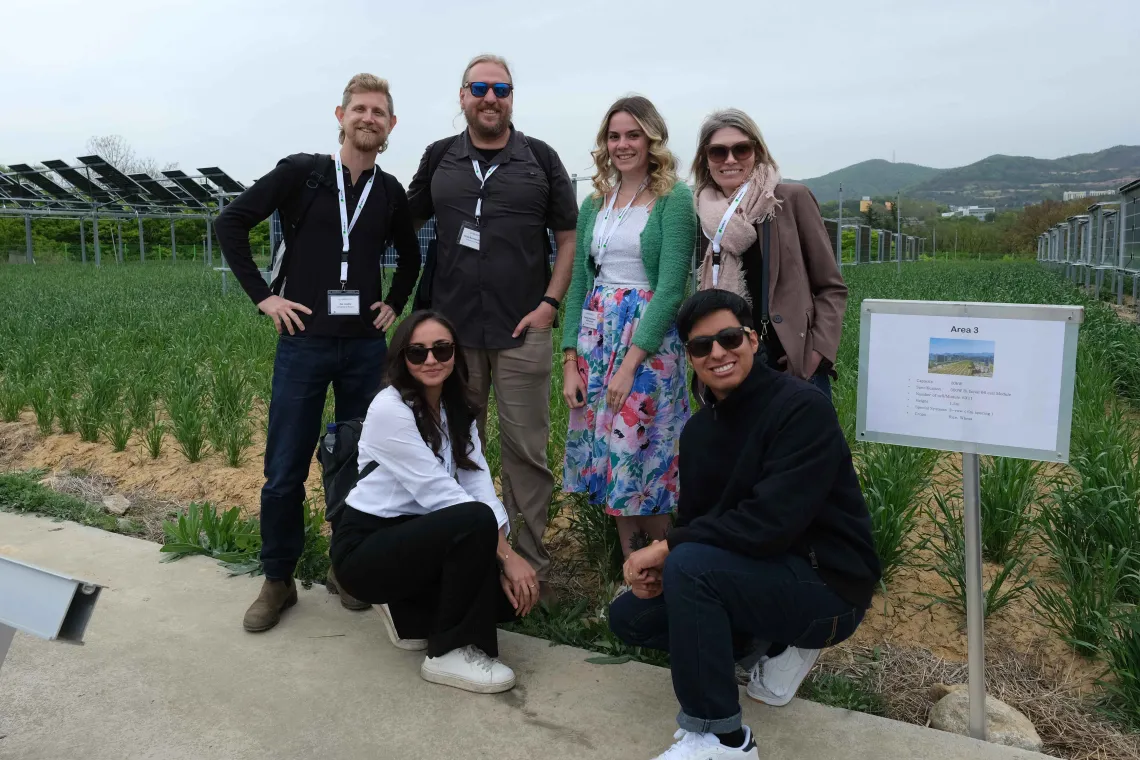
A field trip to an agrivoltaic site in Daegu, South Korea. Pictured from left are (back row) Kai Lepley, Greg Barron-Gafford, Talitha Neesham-McTiernan, (front row) Alyssa Salazar and Caleb Ortega.
Greg Barron-Gafford, former Udall Center Fellow and professor in the UArizona School of Geography, Development and Environment, and Udall Center Director Andrea K. Gerlak traveled with six student researchers to the 2023 agrivoltaics conference in Daegu, South Korea earlier this month. The students were invited to present findings from their recent work and learn from researchers and industry professionals engaging in agrivoltaics research around the world.
Barron-Gafford and Gerlak were recently awarded $1.2 million from the U.S. Department of Energy to study the potential impacts of agrivoltaic projects on water usage for effective crop production.
Barron-Gafford shared results from this work by describing how the shade from overstory solar panels allows for significant water savings for agriculture production and increased food production for a range of crops grown using an agrivoltaics approach. In the study presented, the team had even reduced irrigation by 50 percent with minimal impacts on plant survival and yield.
In collaboration with Alexis Pascaris of AgriSolar Consulting, Gerlak also shared her work examining the drivers and challenges of industry adoption of agrivoltaics in the U.S. Their findings suggest that overcoming the challenges impeding U.S. solar industry adoption of agrivoltaics will require robust market mechanisms that stimulate price improvements in conjunction with coordinated, cross-sector learning processes, research and regulation." Understanding the policy, economic, and social considerations around agrivoltaic adoption is a key part of the story that our team is working on,” says Gerlak.
According to Barron-Gafford, UArizona is on the cutting edge of the emerging science of agrivoltaics. “The University of Arizona supported our work a decade ago – way before the federal funding agencies would take a risk on this very different approach to food and energy production,” Barron-Gafford says. “Now we’re global leaders, and people look to us to describe the state of the art, especially for dryland regions.”
As a result of this leadership, Barron-Gafford points out that UArizona has been invited to cohost the National Renewable Energy Lab in Denver, Colorado. He also says that the international community is taking notice of these developments. “Because we have been engaged in this agrivoltaics approach for so long and because the U.S. Department of Energy and U.S. Department of Agriculture are making significant investments around agrivoltaics research, the international agrivoltaics meeting will be in the U.S. next year,” he says.
Student Research
In addition to shadowing their expert guides and networking with other international agrivoltaic researchers at the South Korea conference, the UArizona students invited to attend were also given the opportunity to present findings from their own agrivoltaic research projects – a professional experience that could help provide a boost for their own careers in research and academia down the line.
But, says Barron-Gafford, participating in such a gathering of minds is about more than just adding a line item to the students’ resumes. It’s also a chance for these up-and-coming researchers to see the effect that their work has on the field and the world at large.
“Being able to support all of these students presenting their work half-way around the world is about more than just sharing great science,” says Barron-Gafford, “It’s also about making sure they feel the impact they are having on a global community of researchers and practitioners.”
This research was funded by and part of broader efforts under the University of Illinois’ SCAPES project (which stands for “Sustainably Colocating Agricultural and Photovoltaic Electricity Systems”) and by internal UArizona funding from the Arizona Institute for Resilience and travel grant funding for students from the Graduate and Professional Student Council.
Read on to learn more about the six student participants at the conference and the research they presented while in attendance.
Alyssa Salazar
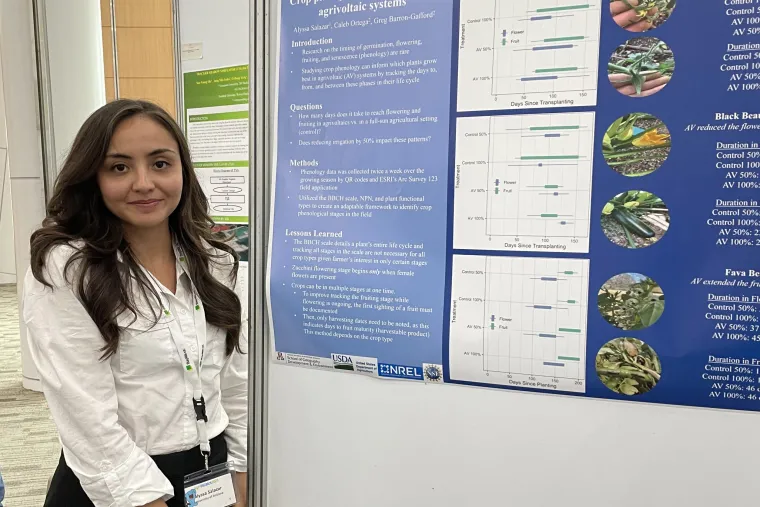
Alyssa Salazar poses next to her poster at the agrivoltaics conference.
Alyssa Salazar shared the findings from her undergraduate thesis on crop plant phenology in dryland agrivoltaics. This project examines the timing of germination, flowering, and fruiting of plants to understand plant life cycle under agrivoltaic conditions.
Said Salazar of her experience, “I am excited to begin my graduate work in the School of Geography, Development & Environment this fall. I have learned a lot through this earlier research and I am looking forward to continuing my phenology research while also studying plant yield under a changing climate in the Southwest.”
Caleb Ortega

Caleb Ortega with his project poster at the South Korea conference.
Caleb Ortega works with the UArizona School Garden Workshop and is a member of the university’s Agrivoltaics Research Group. He presented his work with students at Manzo Elementary School in Tucson, Arizona where he is collecting and processing agrivoltaics data as part of the students’ ecology and science curriculum.
In the garden, students measure plant height, temperature, and other factors and enter data via ESRI’s Survey 123 software on tablet devices using a process Ortega originally developed for data collection at Biosphere 2. “This conference highlights best practices within agrivoltaics around the world for me,” says Ortega. “I can really see how, through networking and collaboration, we can do so much more to advance agrivoltaics around the world.”
Mira Kaibara
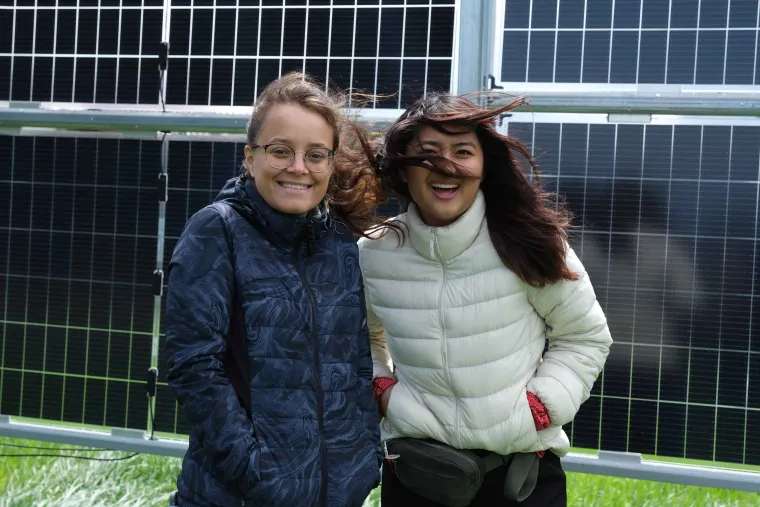
Mira Kaibara (right) poses with graduate student Nesrine Rouini in front of a solar panel installation during a field trip in South Korea.
Mira Kaibara (pictured above on the right in a white jacket) is a Flinn Scholar and undergraduate student at UArizona who has worked in Barron-Gafford’s lab for the past year and a half. Kaibara said that her exposure to the greater professional landscape while attending the conference in South Korea has been an eye-opening experience for her as a researcher looking to sharpen her skillset.
“I am blown away by the global scope of agrivoltaics,” Kaibara said. “It has been an amazing experience to see the diversity of projects around the world.”
Kai Lepley
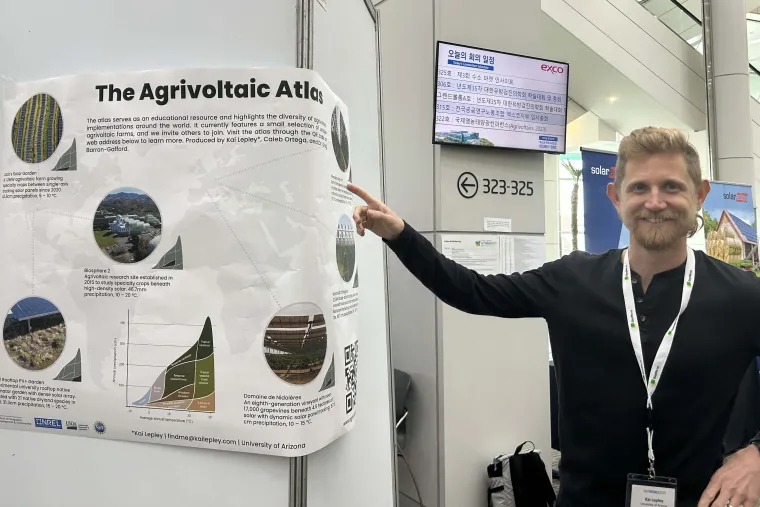
Kai Lepley points at his "Agrivoltaic Atlas" poster while presenting at the agrivoltaic conference.
PhD student in the School of Geography, Development and Environment Kai Lepley shared the interactive website he has been working on which he intends to serve as a global atlas of agrivoltaic projects. Collaborators from around the world can contribute their unique projects to the website to demonstrate the many ways agrivoltaic systems vary with climate and culture. His initial presentation of the atlas was met with strong interest from conference attendees.
Following the conference in Daegu, Lepley was invited to Japan for a tour of Japanese agrivoltaic projects and a seminar on international agrivoltaic research collaboration and policy development. There, he presented an overview of agrivoltaic research and development in the United States to an international audience of scientists, farmers, solar developers, and policymakers. “Attending this event was among the most inspiring moments in my PhD,” Lelpey said of his back-to-back international excursions. “I’m coming away with an abundance of new connections and new ideas to advance agrivoltaic research, inform agrivoltaic policy and promote international collaborations.”
Nesrine Rouini
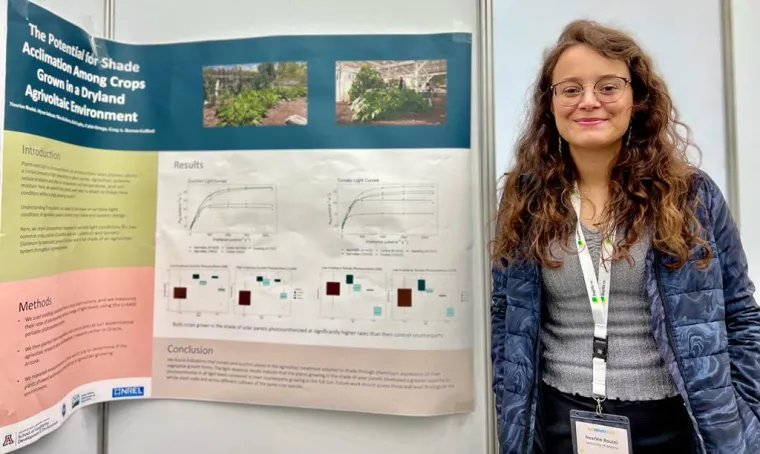
Nesrine Rouini poses with her project poster in Daegu.
Research specialist and graduate student Nesrine Rouini shared her research examining crop plant acclimation to the novel shaded environment of a dryland agrivoltaic system at the Biosphere 2 Research Center. Rouini documented that plants can adapt to the lower light levels within a single growing season.
According to her research, because of the cooler temperatures and lower evaporation rates associated with agivoltiacs, plants that are usually more sun loving thrive in the shade of solar panels. “The best part of the conference was the networking and learning about the work of fellow agrivoltaic researchers and professionals from around the world,” Rouini said.
Talitha Neesham-McTiernan
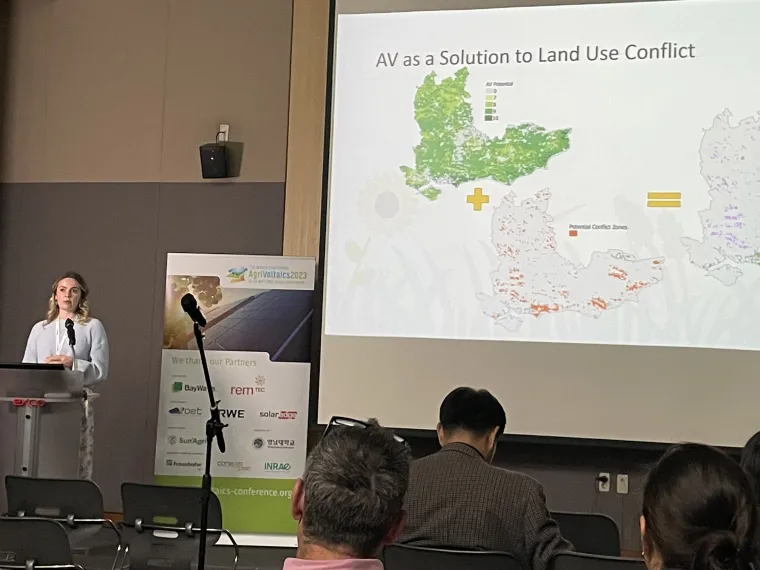
Talitha Neesham-McTiernan presents her work examining "AV as a Solution to Land Use Conflict" during the international agrivoltaics conference.
Talitha Neesham-McTiernan, a PhD student in the School of Geography, Development & Environment, shared her research analyzing the suitability of agrivoltaics in Great Britain to alleviate the “food versus fuel” land use conflicts there. She is now expanding her research to the United States, where she is applying her suitability analysis approach to explore the impact of projected climate change on agrivoltaic suitability.
“Attending the AgriVoltaics2023 conference has been a really wonderful and valuable opportunity to collaborate and exchange knowledge with researchers from across the globe who share a common vision of the potential of agrivoltaics for sustainable food and energy production,” said Neesham-McTiernan.

